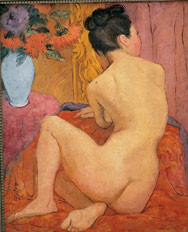Life
Naked truths
By Zhu Linyong (China Daily)
Updated: 2010-12-24 08:19
 |
Large Medium Small |
|
Pioneering woman artist Pan Yuliang's modernist nudes from the 1930s are highlights of the exhibition. Provided to China Daily |
Self Portrait: Woman's Art in China (1920-2010), now on at Cafa Art Museum at the Central Academy of Fine Arts, organizers say, is the largest exhibition of works by women artists in a year that marks the 100th anniversary of International Women's Day.
On view are more than 100 works created by celebrated Chinese women artists over the past century.
Female figures, as objects of art, first appeared on silk in the Warring States Period (475-221 BC) and Western Han Dynasty (206 BC-AD 24).
According to curator and critic Jia Fangzhou, "Women were seen as just beautiful objects to show off or admire."
Historical records rarely mentioned women artists and even those that did usually addressed them by their husband's surname.
For instance, Madame Zhao, a concubine of Sun Quan, king of Wu State (AD 222-280) finds a mention in Jin Dynasty (AD 265-420) historian Chen Shou's History of the Three Kingdoms Period for her map-drawing and landscape-painting skills.
However, most women artists remained obscure.
"But the last century witnessed their rise; women artists today are painting their own images and their perceptions of social reality", Jia says.
The exhibits, ranging from paintings and sculpture to installation and mixed media works, are on loan from a string of museums, galleries and private collections; the earliest works date back to the 1920s and the latest ones are as recent as early 2010.
The early works are mostly self-portraits and reflect the strong influence of the artists' male contemporaries in both technique and content, according to art historian Liao Wen.
However, with China's reform and opening-up in the early 1980s, Western art ideas and techniques, and especially feminist notions, flooded into the local art scene.
Women artists gradually found their own voice, Liao says. Public awareness of women artists and tolerance of their art also improved dramatically over the past century.
Today, a nude self-portrait would hardly raise an eyebrow but in the early 20th century, it was taboo, says critic Tao Yongbai.
For example, Pan Yuliang (1895-1977), a pioneering woman artist drew both acclaim and criticism for her nudes.
Her modernist nude oils stirred widespread controversy when shown to a conservative public in the 1930s. Some of her portraits, first exhibited in 1929, are included in the exhibition that is on till Feb 20.
Besides traditional ink paintings, many women artists have also tried their hand at a wealth of mediums, styles, and techniques.
In Xiang Jing's pink sculpture of female nudes, one may read a sense of bewilderment, a reflection of women in a fast-changing society.
Yin Xiuzhen's huge, futuristic cloth patchwork with peep holes, hints at the many perspectives from which women today are viewed.
Peng Wei's experimental ink art, that uses traditional motifs closely associated with women, such as shoes with embroidery patterns, and traditional underwear for women, sheds light on the changing image of Chinese women.
